In this chapter, we will cover cross-site forgery. This topic is not exactly new, and believe it or not, we have already encountered this in the previous chapters. In this chapter, we will go deeper into cross-site forgery and learn the various techniques of defending against it.
Cross-site request forgery (CSRF) exploits the trust that a site has in a user's browser. It is also defined as an attack that forces an end user to execute unwanted actions on a web application in which the user is currently authenticated. We have seen at least two instances where CSRF has happened. Let's review these security issues now.
We will now take a look at a basic CSRF example:
- Go to the source code provided for this chapter and change the directory to
chp4/python_tornado. Run the following command:python xss_version.py - Remember to start your MongoDB process as well.
- Next, open
external.htmlfound intemplates, in another host, sayhttp://localhost:8888. You can do this by starting the server, which can be done by runningpython xss_version.py –port=8888, and then visitinghttp://loaclhost:8888/todo_external. You will see the following screenshot:
Adding a new to-do item
- Click on Add To Do, and fill in a new to-do item, as shown in the following screenshot:
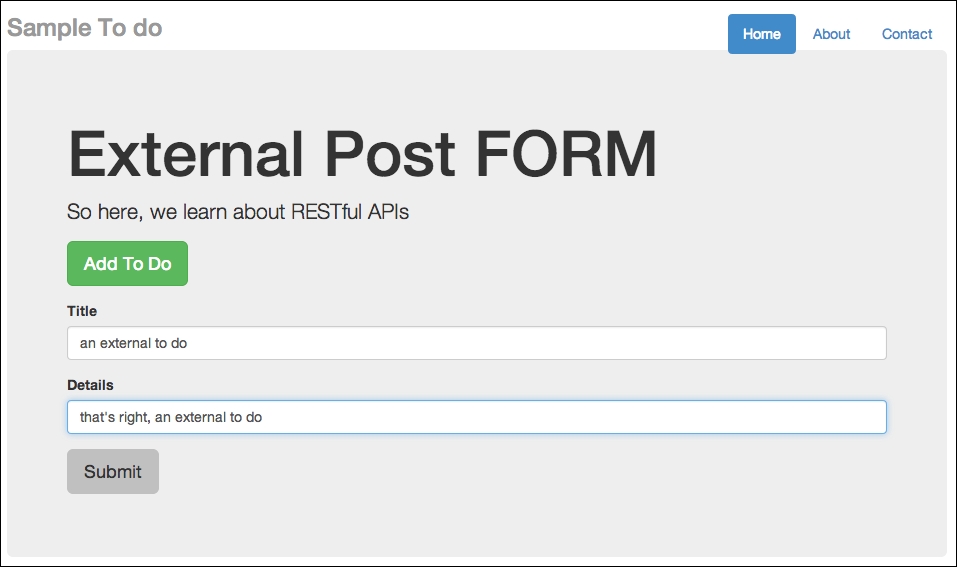
Adding a new to-do item and posting it
- Next, click on Submit. Going back to your to-do list app at
http://localhost:8000/todoand refreshing it, you will see the new to-do item added to the database, as shown in the following screenshot:
To-do item is added from an external app; this is dangerous!
- As we saw in the previous chapter, to attack the to-do list app, all we need to do is add a new item that contains a line of JavaScript, as shown in the following screenshot:
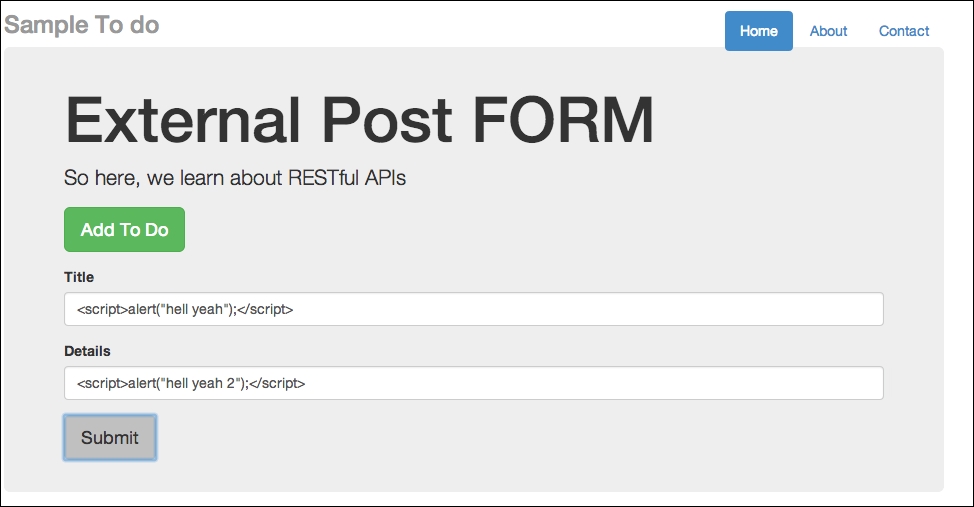
Adding a new to do for the Python version
- Now, click on Submit. Then, go back to your to-do app at
http://localhost:8000/todo, and you will see two subsequent alerts, as shown in the following screenshot: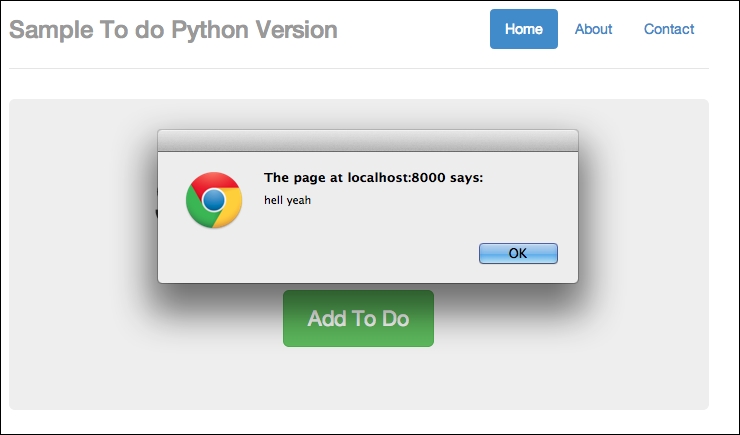
Successfully injected JavaScript part 1
- So here's the first instance where CSRF happens:
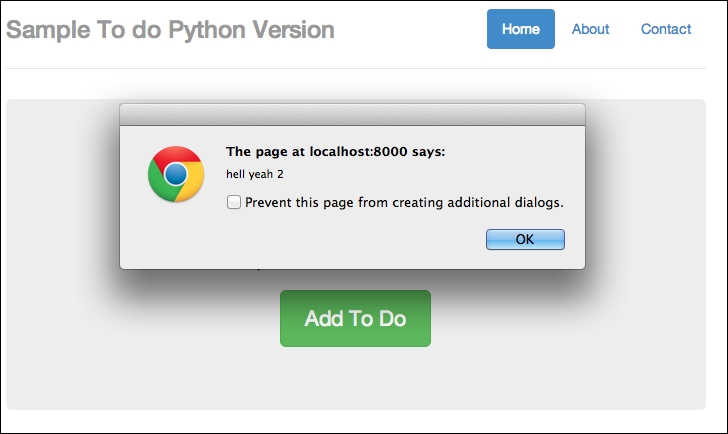
Successfully injected JavaScript part 2
Take note that this can happen to the other backend written in other languages as well. Now go to your terminal, turn off the Python server backend, and change the directory to
node/. Start the node server by issuing this command:node server.jsThis time around, the server is running at
http://localhost:8080, so remember to change the$.post()endpoint tohttp://localhost:8080instead ofhttp://localhost:8000inexternal.html, as shown in the following code:function addTodo() { var data = { text: $('#todo_title').val(), details:$('#todo_text').val() } // $.post('http://localhost:8000/api/todos', data, function(result) { $.post('http://localhost:8080/api/todos', data, function(result) { var item = todoTemplate(result.text, result.details); $('#todos').prepend(item); $("#todo-form").slideUp(); }) }The line changed is found at
addTodo(); the highlighted code is the correct endpoint for this section. - Now, going back to
external.html, add a new to-do item containing JavaScript, as shown in the following screenshot: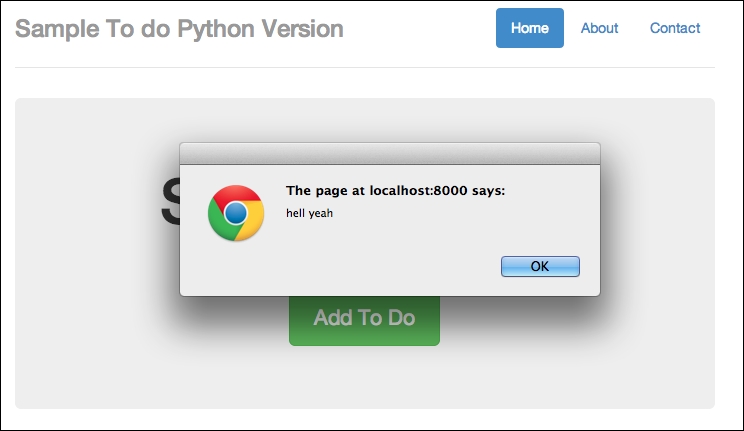
Trying to inject JavaScript into a to-do app based on Node.js
- As usual, submit the item. Go to
http://localhost:8080/api/and refresh; you should see two alerts (or four alerts if you didn't delete the previous ones). The first alert is as follows: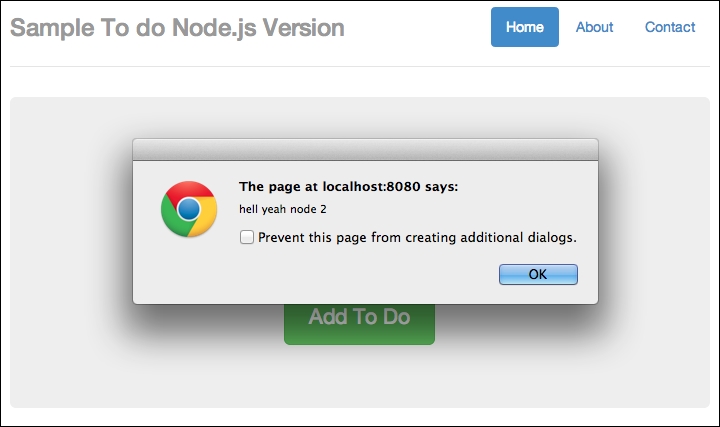
Successfully injected JavaScript part 1
The second alert is as follows:
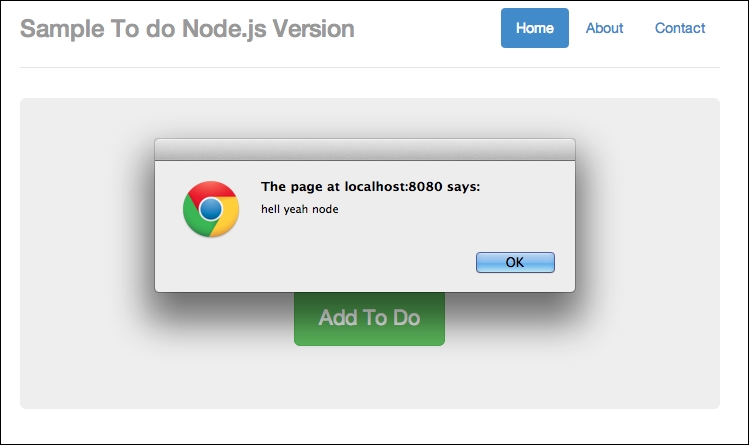
Successfully injected JavaScript part 1
Now that we have seen what can happen to our app if we suffered a CSRF attack, let's think about how such attacks can happen.
Basically, such attacks can happen when our API endpoints (or URLs accepting the requests) are not protected at all. Attackers can exploit such vulnerabilities by simply observing which endpoints are used and attempt to exploit them by performing a basic HTTP POST operation to it.
If you are using modern frameworks or packages, the good news is that you can easily protect against such attacks by turning on or making use of CSRF protection. For example, for server.py, you can turn on xsrf_cookie by setting it to True, as shown in the following code:
class Application(tornado.web.Application):
def __init__(self):
handlers = [
(r"/api/todos", Todos),
(r"/todo", TodoApp)
]
conn = pymongo.Connection("localhost")
self.db = conn["todos"]
settings = dict(
xsrf_cookies=True,
debug=True,
template_path=os.path.join(os.path.dirname(__file__), "templates"),
static_path=os.path.join(os.path.dirname(__file__), "static")
)
tornado.web.Application.__init__(self, handlers, **settings)Note the highlighted line, where we set xsrf_cookies=True.
For the version of the node server, you can refer to chp4/node/server_secure.js, where we require csrf. Have a look at the following code snippet:
var express = require('express'),
var bodyParser = require('body-parser'),
var app = express();
var session = require('cookie-session'),
var csrf = require('csrf'),
app.use(csrf());
app.use(bodyParser());The highlighted lines are the new lines (compared to server.js) to add in CSRF protection.
Now that both backends are equipped with CSRF protection, you can try to make the same post from external.html. You will not be able to make any post from external.html. For example, you can open Chrome's developer tool and go to Network. You will see the following:

POST forbidden
On the terminal, you will see a 403 error from our Python server, which is shown in the following screenshot:

POST forbidden from the server side
